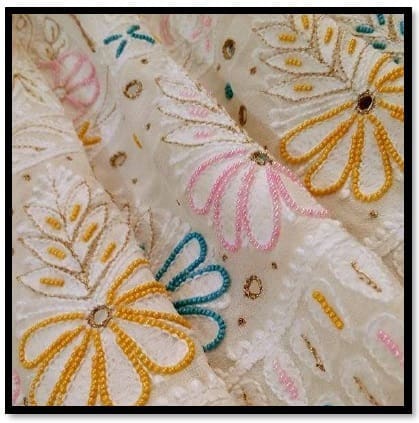The traditional embroidery style introduced by Mughals in Lucknow, is one of the most ancient and popular art form. It is more than 400 years old traditional art form of India. The word ‘Chikankari’ is derived from the Persian word ‘Chakeen’.
Lucknow is also known as hub of chikan work.

ORIGIN AND HISTORY
History witnesses so many references for arts similar to chikan work in India, use of flowered muslins.
There are several tales on the origin of chikan work. Around 3rd century, there was a traveler who taught this beautiful art work to a peasant, in return of drinking water.
And the most favored and factually provable story is of Noor Jahan, Mughal empress and wife of Jahangir, introduced chikan work in 17th century inspired from Persian artwork. She made white-on white embroidery (cotton thread on muslin cloth) cap for her husband. She was a talented embroideress, and fond of arts.
The Chikankari artisans spreads all over India, after the downfall of Mughals, but Lucknow and Awadh remained the main centre.
TECHNIQUE
The method can be divided into five basic steps:
•Design: Determining of design according to our final product.
• Engraving: The determined deign is engraved or carved on wooden blocks.
• Block Printing: These blocks are used for printing design on the cloth with the help of neel or safada dyes.
• Embroidery: Tightly set fabric in a small size frame or hoop, then the needlework begins according to the design drafted. Use of stitches also depends on the design, according to the type and size of motifs. Chikankari widely uses the backstitch, chainstitch, hemstitch and jali work.
• Washing and Finishing: And after completing embroidery work, fabric is washed carefully to remove all the traces of printed design. And at last the fabric is starched to obtain appropriate stiffness.
GI TAG
Geographical Indication Registry (GIR) pact Geographical Indication (GI) status for Chikankari in December 2008, which recognized Lucknow as an exclusive centre of Chikankari.
COLORS AND VARIETIES
The traditional Chikankari is white-on-white embroidery work on muslin cloth, but now the  Chikankari artisans has developed a new idea of using colors. Now, colorful garments of chikan work are easily available in markets with a choice of fabric also such as muslim, cotton, silk, chiffon, organza, etc. And embellishment work like mukaish, sequin, badla, mirrorwork, bead and kamdani also get started.
Chikankari artisans has developed a new idea of using colors. Now, colorful garments of chikan work are easily available in markets with a choice of fabric also such as muslim, cotton, silk, chiffon, organza, etc. And embellishment work like mukaish, sequin, badla, mirrorwork, bead and kamdani also get started.
Generally, the color of fabric is lighter than the color of embroidery thread as the embroiderer wishes to highlight their work. Chikankari is mostly done on fabrics like cotton, crepe, chiffon, georgette, silk or any other which is thin and soft.
MOTIFS
 Motifs are inspired from Persian art, due to which they are having a strong impact of Persian designs. Mostly motifs used are of floral pattern, stem, buti (pasley),and leaves. And the most unique and identical jali work is done in motifs.
Motifs are inspired from Persian art, due to which they are having a strong impact of Persian designs. Mostly motifs used are of floral pattern, stem, buti (pasley),and leaves. And the most unique and identical jali work is done in motifs.
PRICE RANGE
Chikankari garments like lucknowi chikan kurtas dupatta or palazzo starts from Rs.1000 to Rs.8000 and it varies according to the size and material of garment and the most depends on the intricacy of work.
In local shops Chikankari is also available in very low price (starts Rs.200) but they are not handcrafted, so they don’t have that exactness and neatness in their work.
HOW TO CARE?
Usually the chikan work is dry-cleaned especially if it is on silk fabric or with silk thread. Cotton can be hand washed at home.
References
1. https://gailcreativestudies.wordpress.com/2017/04/27/chikankari-the-floral-white-work-of-india-guest-blogger-penny-peters/7-peacock-front-closeup010/
2. https://in.pinterest.com/pin/538954280402259800/
3. https://www.facebook.com/LucknowChikankaridress/photos/buy-onlinehttpwwwdress365dayscompure-georgette-chikankari-suits-catid-249897pa/1604670996292932/
4. https://lbb.in/bangalore/lucknowi-chikan-centre-summer-ready-kurtis-koramangala/

